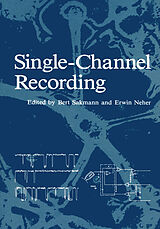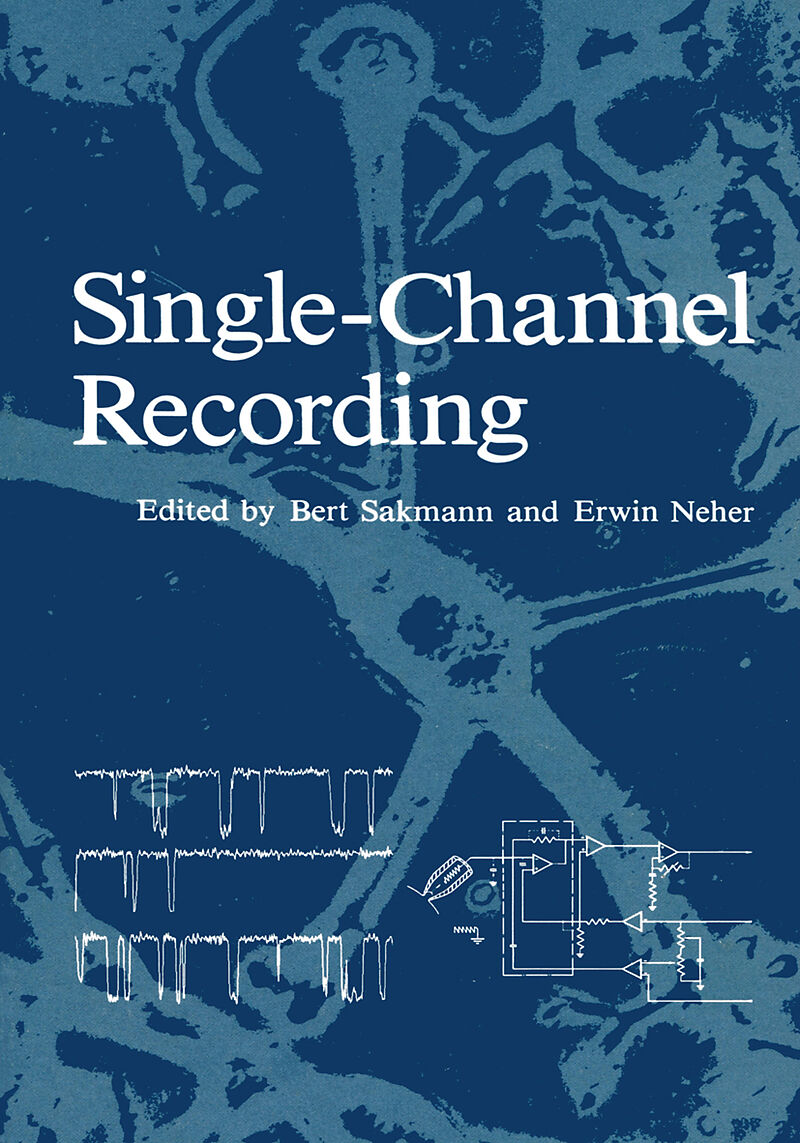Single-Channel Recording
Format:
E-Book (pdf)
EAN:
9781461578581
Genre:
Biologie
Herausgeber:
Springer US
Anzahl Seiten:
504
Erscheinungsdatum:
11.11.2013
Single-channel recording has become a widely used tool for the study of ion permeation mechanisms in biological membranes. Whereas the technique might have been considered an "art" after its introduction in 1976, it developed into a relatively simple method after it became possible to obtain high-resistance (several gigaohm) membrane-pipette seals. In the summer of 1982, a course on the technique was held at the Ettore Majorana Center for Scientific Culture in Erice, Sicily. It brought together people from most of the laboratories involved in patch clamping at that time. During the course, it became apparent that the technique had reached a state of maturity. Repeatedly, the opinion was expressed that a detailed description of all the aspects of the technique including representative examples of results should be available. We therefore asked the course instructors, as well as several other colleagues, to provide chapters on selected topics in order to produce this volume. The different variants of patch clamping were described quite extensively in an article by Hamill, Marty, Neher, Sakmann, and Sigworth (Pflugers Archiv 391:85) in 1981. Rather than repeating this survey in an introductory chapter, we chose to reprint that article in the Appendix of this volume (by permission of Springer-Verlag). The methods section will, therefore, go straight into detailed aspects of the technol ogy.
Inhalt
I. Methods.- 1 Electronic Design of the Patch Clamp.- 1. Introduction.- 2. Current-Measurement Circuitry.- 2.1. Current-Voltage Converter.- 2.2. Dynamics of the I-V Converter.- 2.3. Correcting the Frequency Response.- 3. Background Noise in the Current-Voltage Converter.- 3.1. Noise in the Feedback Resistor.- 3.2. Noise in the Amplifier.- 3.3. Example of a Low-Noise Amplifier Design.- 3.4. Summary of Noise Sources.- 4. Capacitance Transient Cancellation.- 4.1. Overload Effects in the Patch Clamp.- 4.2. Fast Transient Cancellation.- 4.3. Slow Transient Cancellation.- 5. Series Resistance Compensation.- 5.1. Theory.- 5.2. Effect of Fast Transient Cancellation.- 5.3. Incorporating Slow Transient Cancellation.- 5.4. A High-Speed, "Chopping" Voltage Clamp.- References.- 2 Geometric Parameters of Pipettes and Membrane Patches.- 1. Introduction.- 2. Geometry of Patch Pipettes.- 2.1. Tip Shape of Soft Glass Pipettes.- 2.2. Tip Shape of Hard Glass Pipettes.- 2.3. Tip Shape of Thick-Walled Pipettes.- 3. Geometry of Membrane Patches.- 3.1. Patch Area by Observation in the Light Microscope.- 3.2. Patch Area as Measured by Patch Capacitance.- 4. Conclusions.- References.- 3 Science and Technology of Patch-Recording Electrodes.- 1. Introduction.- 2. Science.- 2.1. Glass Structure.- 2.2. Membrane Structure.- 2.3. Glass-Membrane Interactions.- 3. Technology.- 3.1. Choice of Glass.- 3.2. Pulling.- 3.3. Coating.- 3.4. Polishing.- 3.5. Filling.- References.- 4 Enzymatic Dispersion of Heart and Other Tissues.- 1. Introduction.- 2. Methods.- 2.1. Outline of Dissociation Processes.- 2.2. Access of the Solution to the Tissue.- 2.3. Enzymes.- 2.4. Calcium.- 2.5. Tests of Viability.- 3. Mammalian Heart.- 3.1. Dissociation Techniques.- 3.2. Gigaseals.- References.- 5 A Primer in Cell Culture for Patchologists.- 1. Introduction.- 2. The Spectrum of Cell Cultures.- 2.1. Primary Cultures.- 2.2. Cell Lines.- 3. Some Methodological Considerations.- 3.1. Primary Cell Cultures.- 3.2. Culture Milieu.- References.- 6 Patch-Clamped Liposomes: Recording Reconstituted Ion Channels.- 1. Introduction.- 2. Small Unilamellar Vesicles and Recording Accessibility.- 3. Large Liposomes from Small Unilamellar Vesicles.- 4. Gigaseals and Isolated Patches with Freeze-Thaw Liposomes.- 5. Reconstituted AChR and Chloride Channels from Torpedo Electroplax.- 6. Conclusions.- References.- 7 Tight-Seal Whole-Cell Recording.- 1. Introduction.- 2. Procedures and Techniques.- 2.1. General Description of the Method.- 2.2. Pipettes.- 2.3. Electronics.- 2.4. Cell Capacitive Current.- 2.5. Solutions for Filling Whole-Cell Pipettes.- 3. Evaluation of the Whole-Cell Clamp.- 3.1. Ease of Penetration.- 3.2. The Equivalent Circuit.- 3.3. Cell Size and Quality of Clamp.- 3.4. Exchange of Cell Content with Pipette Solution.- 3.5. Junction Potential Drift Caused by the Loss of Cell Constituents...- 3.6. Modification of Channels following the Loss of Cell Constituents..- 3.7. Background Noise of a Whole-Cell Voltage-Clamp Measurement.. 117 4. Conclusion.- References.- 8 The Loose Patch Clamp.- 1. Introduction.- 2. Setup.- 2.1. Pipettes.- 2.2. Principle of Method and Recording Circuitry.- 2.3. Main Amplifier.- 2.4. Series Resistance Correction.- 2.5. Digital Hardware.- 3. Some Examples and Applications.- 3.1. Potential Control.- 3.2. Some Further Applications.- 3.3. Limitations of the Method.- References.- II. Concepts and Analysis.- 9 The Principles of the Stochastic Interpretation of Ion-Channel Mechanisms.- 1. The Nature of the Problem.- 1.1. Reaction Mechanisms and Rates.- 1.2. Rate Constant and Probabilities.- 2. Probabilities and Conditional Probabilities.- 3. The Distribution of Random Time Intervals.- 3.1. Another Approach to the Exponential Distribution.- 3.2. Generalization.- 3.3. Relationship between Single-Channel Events and Whole-Cell Currents.- 3.4. The Length of Time Spent in a Set of States.- 4. A Mechanism with More Than One Shut State: The Simple Open Ion Channel-Block Mechanism.- 4.1. A Simple Ion Channel-Block Mechanism.- 4.2. Relaxation and Noise.- 4.3. Open Lifetimes of Single Channels.- 4.4. Shut Lifetimes of Single Channels.- 4.5. Bursts of Openings.- 4.6. Lifetime of Various States and Compound States.- 4.7. Derivation of Burst Length Distribution for Channel-Block Mechanism.- 5. A Simple Agonist Mechanism.- 6. Some Fallacies and Paradoxes.- 6.1. The Waiting Time Paradox.- 6.2. The Unblocked Channel Fallacy.- 6.3. The Last Opening of a Burst Fallacy.- 6.4. The Total Open Time per Burst Paradox.- 7. Reversible and Irreversible Mechanisms.- 7.1. A Simple Example.- 7.2. Distribution of the Lifetime of an Opening.- 7.3. Probabilities of Particular Sequences of Transitions When the Open States are Distinguishable.- 8. The Problem of the Number of Channels.- 8.1. Estimation of the Number of Channels.- 8.2. Evidence for the Presence of Only One Channel.- 8.3. Use of Shut Periods within Bursts.- 9. Distribution of the Sum of Two Random Intervals.- 10. A More General Approach to the Analysis of Single-Channel Behavior...- 10.1. Specification of Transition Rates.- 10.2. Derivation of Probabilities.- 10.3. The Open Time and Other Distributions.- 10.4. A General Approach to Bursts of Ion-Channel Openings.- 10.5. Some Conclusions from the General Treatment.- References.- 10 Conformational Transitions of Ionic Channels.- 1. Introduction.- 2. Two-State Channel with a Single Binding Site.- 2.1. Concentration Dependence of Conductance.- 2.2. Carrierlike Behavior of Channels.- 2.3. Single-Channel Currents with Rectifying Behavior.- 3. Nonequilibrium Distribution of Long-Lived Channel States.- 4. Current Noise in Open Channels.- 5. Conclusion.- References.- 11 Fitting and Statistical Analysis of Single-Channel Records.- 1. Introduction.- 2. Acquiring Data.- 2.1. Transient Recorders.- 2.2. Computer On Line or from Magnetic Tape.- 2.3. Filtering the Data.- 2.4. Digitizing the Data.- 3. Finding Channel Events.- 3.1. Description of the Problem.- 3.2. Choosing the Filter Characteristics.- 3.3. Setting the Threshold.- 3.4. Practical Event Detection.- 4. Characterizing Single-Channel Events.- 4.1. Direct Fitting of the Current Time Course.- 4.2. Half-Amplitude Threshold Analysis.- 4.3. Event Characterization Using a Computer.- 5. The Display of Distributions.- 5.1. Histograms and Probability Density Functions.- 5.2. Missed Brief Events: Imposition of a Consistent Time Relationship.- 5.3. The Amplitude Distribution.- 5.4. The Open and Shut Lifetime Distributions.- 5.5. Burst Distributions.- 5.6. Clus…

Leider konnten wir für diesen Artikel keine Preise ermitteln ...
billigbuch.ch sucht jetzt für Sie die besten Angebote ...
Die aktuellen Verkaufspreise von 3 Onlineshops werden in Realtime abgefragt.
Sie können das gewünschte Produkt anschliessend direkt beim Anbieter Ihrer Wahl bestellen.
Loading...
Die aktuellen Verkaufspreise von 3 Onlineshops werden in Realtime abgefragt.
Sie können das gewünschte Produkt anschliessend direkt beim Anbieter Ihrer Wahl bestellen.
| # | Onlineshop | Preis CHF | Versand CHF | Total CHF | ||
|---|---|---|---|---|---|---|
| 1 | Seller | 0.00 | 0.00 | 0.00 |
